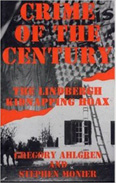
 |
Crime of the Century: The Lindbergh Kidnapping Hoax
by Gregory Ahlgren and Stephen Monier
Branden Books
On the evening of March 1, 1932, Charles Lindbergh, Jr., the oldest child of the famous aviator and his wife, budding author Anne Morrow Lindbergh, was kidnapped. Within a half an hour not only were the local and state authorities involved in the investigation but even the media had learned of the event. The case electrified the nation, and the discovery of the child's body over two months later created even more outrage and sympathy. Feelings among the nation were so strong that there were some families that offered one of their own children to replace the Lindbergh baby. On September 19, 1934, a German immigrant with a criminal record named Richard Hauptmann was arrested, questioned, and eventually executed for the crime. But was Hauptmann really guilty as charged, or was there someone much closer to the child to blame?
In their well-researched and thought-provoking revisiting of the case, Ahlgren and Monier—one a criminal defense lawyer and the other a United States marshal—cast doubt on the investigation's findings. Much of the evidence obtained to convict Hauptmann was circumstantial at best, and occurrences surrounding the crime such as Charles Lindbergh's complete calm and total control of the investigation, a lack of any fingerprints at all in the child's room, Lindbergh's uncustomary behavior just prior to the kidnapping, and his insistence that his son's body be cremated shortly after being identified and before an autopsy could be performed seem extremely suspicious in hindsight. Could one of Lindbergh's infamous practical jokes have backfired? Could he have been responsible for his own son's death?
Probing into the psychology and personality of Lindbergh, the reliability of certain witnesses, and questionable "facts" related to the case, the authors offer an intriguing second opinion to what has traditionally been seen as history. Their efforts result in a fascinating read.
RECOMMENDED by the US Review